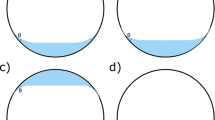Abstract
Background
The use of perfluorohexyloctane as a heavier-than-water tamponade for long-term use is limited by its tendency to dispersion and associated intraocular inflammation. Double-filling with silicone oil and F6H8 produces a united, two-layer bubble, appearing as a single bubble. This has been proposed as a method of improving the utility of F6H8 as a tamponade.
Methods
A surface modified polymethylmethacrylate model eye chamber was double-filled with perfluorohexyloctane and silicone oil to approximate a 90% fill. The proportion of silicone oil was increased in a stepwise fashion. A qualitative comparison of surface contact at each stage was made. Chambers with one, two or no indent were used. Dispersion by agitation of the chamber was assessed.
Results
With less than 20% silicone oil it was difficult to force the two liquids to make contact. With more oil they united in the form of a single bubble joined at an interface. Once joined, the sides of the single bubble were drawn away from the wall of the chamber. As the proportion of silicone oil increased the area of lost contact increased and progressed inferiorly. Compared to F6H8 alone the double-fill reduced dispersion.
Conclusion
Silicone oil and F6H8 can unite to form a single bubble that changes the effectiveness of either tamponade agent on their own. The double-fill needs to have enough silicone oil to form a single bubble, but this needs to be kept as low as possible to avoid progressive loss of lateral tamponade. It does not provide good simultaneous superior and inferior tamponade. The double-fill reduces dispersion.




Similar content being viewed by others
References
Bottoni F, Arpa P, Vinciguerra P, Zenoni S, De Molfetta V (1992) Combined silicone and fluorosilicone oil tamponade (double filling) in the management of complicated retinal detachment. Ophthalmologica 204:77–81
Crisp A, de Juan E Jr, Tiedeman J (1987) Effect of silicone oil viscosity on emulsification. Arch Ophthalmol 105:546–550
DeJuan E Jr, McCuen B, Tiedman J (1985) Intraocular tamponade and surface tension. Surv Ophthalmol 30:47–50
Fawcett IM, Williams R, Wong D (1994) Contact angles of substances used for internal tamponade in retinal detachment surgery. Graefes Arch Clin Exp Ophthalmol 232:438–444
Hiscott P, Magee RM, Colthurst M, Lois N, Wong D (2001) Clinicopathological correlation of epiretinal membranes and posterior lens opacification following perfluorohexyloctane tamponade. Br J Ophthalmol 85:179–183
Kirchhof B, Wong D, Van Meurs J, Hilgers RD, Macek M, Lois N, Schrage NF (2002) Use of perfluorohexyloctane as a long-term internal tamponade agent in complicated retinal detachment surgery. Am J Ophthalmol 133:95–101
Meinert H, Roy T (2000) Semifluorinated alkanes. A new class of compounds with outstanding properties for use in ophthalmology. Eur J Ophthalmol 10:189–197
Singh AK, Glaser BM, Lemor M, Michels RG (1986) Gravity-dependent distribution of retinal pigment epithelial cells dispersed into the vitreous cavity. Retina 6:77–80
Sparrow J, Jayakumar A, Berrocal M, Ozmert E, Chang S (1992) Experimental studies of the combined use of vitreous substitutes of high and low specific gravity. Retina 12:134–140
Wong D, Williams RL, German M (1998) Gas or oil/perfluorodecalin exchange: a model to avoid slippage. Graefes Arch Clin Exp Ophthalmol 236:234–237
Zeana D, Becker J, Kuckelkorn R, Kirchhof B (1999) Perfluorohexyloctane: a long-term vitreous tamponade in the experimental animal. Int Ophthalmol 23:17–24
Acknowledgements
The authors thank Prof. Meinert and Fluoron Gmbh, Neu-Ulm, Germany, for providing the F6H8 and silicone oil.
Author information
Authors and Affiliations
Corresponding author
Additional information
The authors have no financial interest in the devices described.
Rights and permissions
About this article
Cite this article
Herbert, E., Stappler, T., Wetterqvist, C. et al. Tamponade properties of double-filling with perfluorohexyloctane and silicone oil in a model eye chamber. Graefe's Arch Clin Exp Ophthalmol 242, 250–254 (2004). https://doi.org/10.1007/s00417-003-0830-6
Received:
Revised:
Accepted:
Published:
Issue Date:
DOI: https://doi.org/10.1007/s00417-003-0830-6




